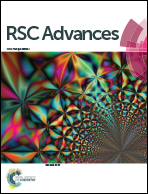Uniform gallium oxyhydroxide nanorod anodes with superior lithium-ion storage†
Abstract
Exploration of a novel metal oxyhydroxide material provides potential candidates for lithium ion battery (LIB) anodes. In the present work, uniform GaOOH nanorods have been successfully synthesized via a simple hydrothermal method and employed as an anode material for LIBs for the first time. The obtained GaOOH nanorods show a high-purity phase with an average length of ∼1.4 μm and a width of ∼100 nm. As an anode, it delivers a stable capacity of ∼1089 mA h g−1 at a 0.5 A g−1 current density upon 300 cycles and a high rate capacity of ∼639 mA h g−1 at 2 A g−1, where the pseudocapacitance plays a dominant role with a capacity contribution ratio of about 83% at 2.0 mV s−1. This enhanced storage performance can be attributed to a 1D nanostructure with efficient electron and ion transfer as well as strain relaxation upon multiple-cycling.



 Please wait while we load your content...
Please wait while we load your content...